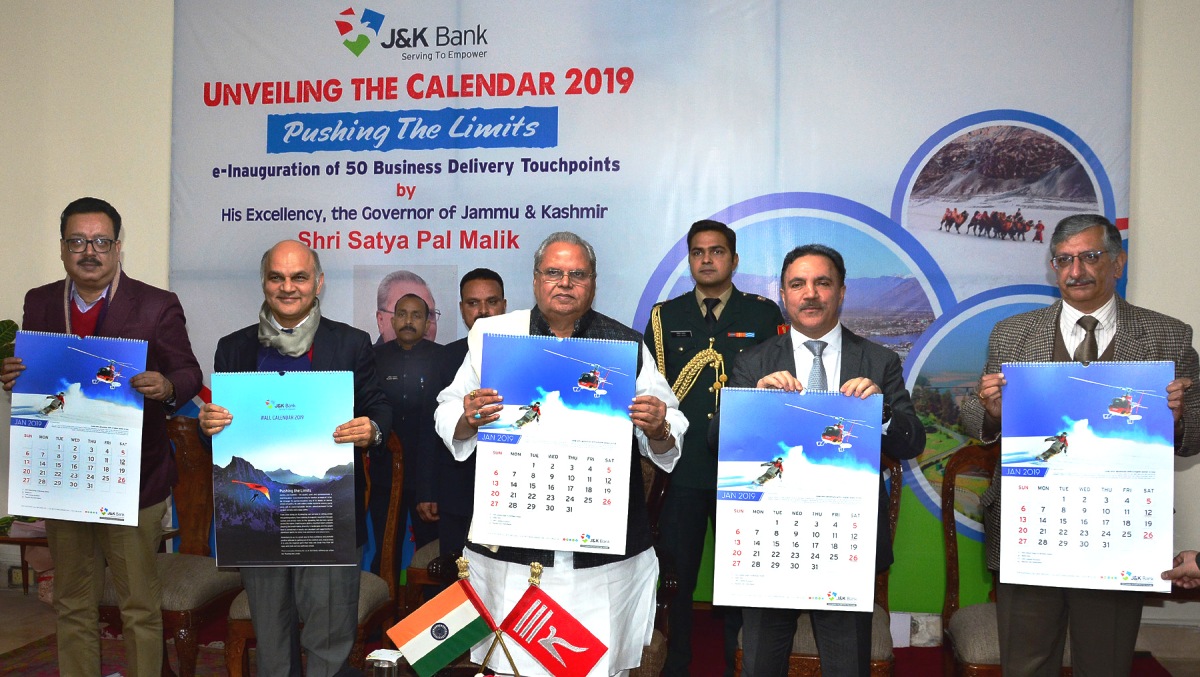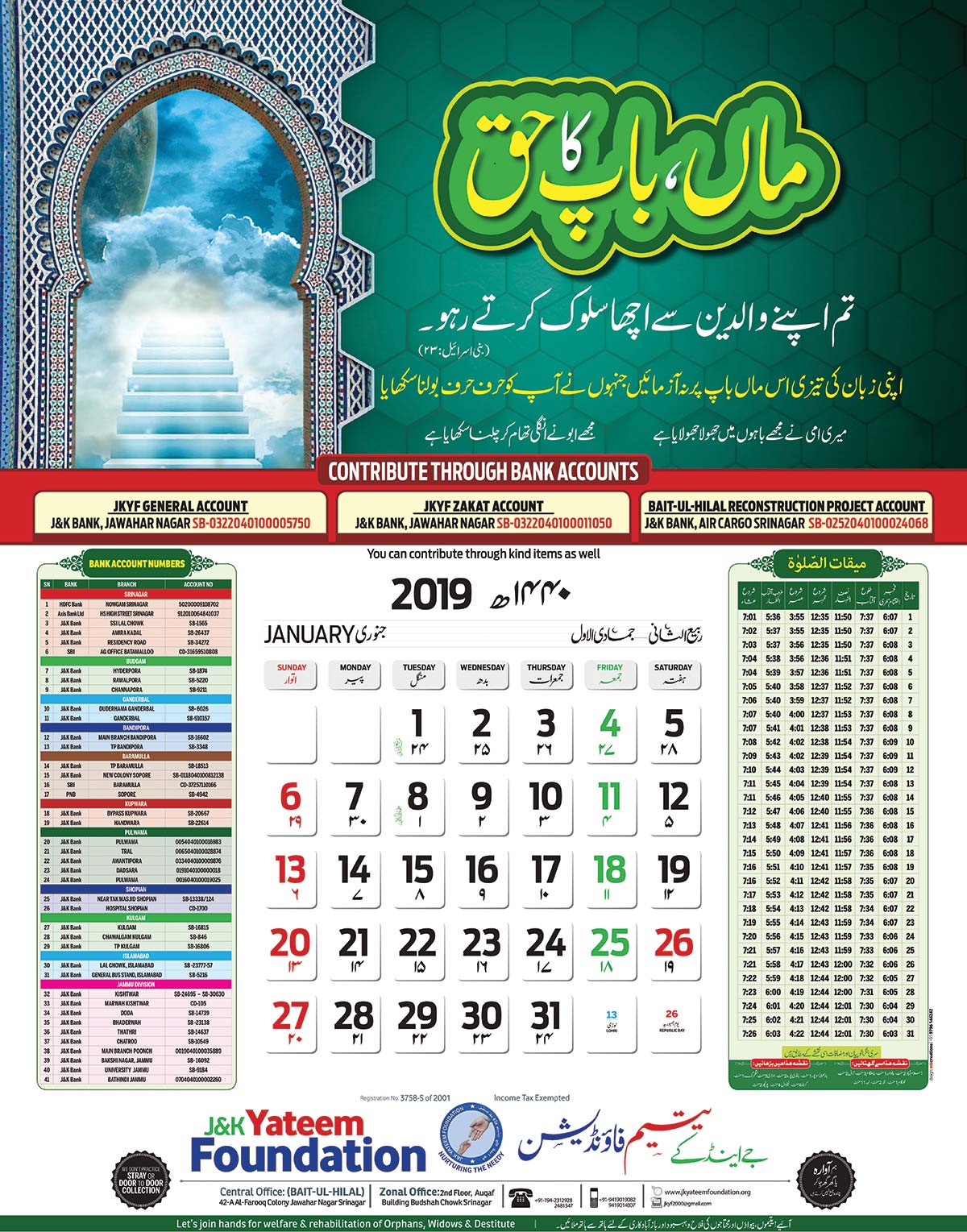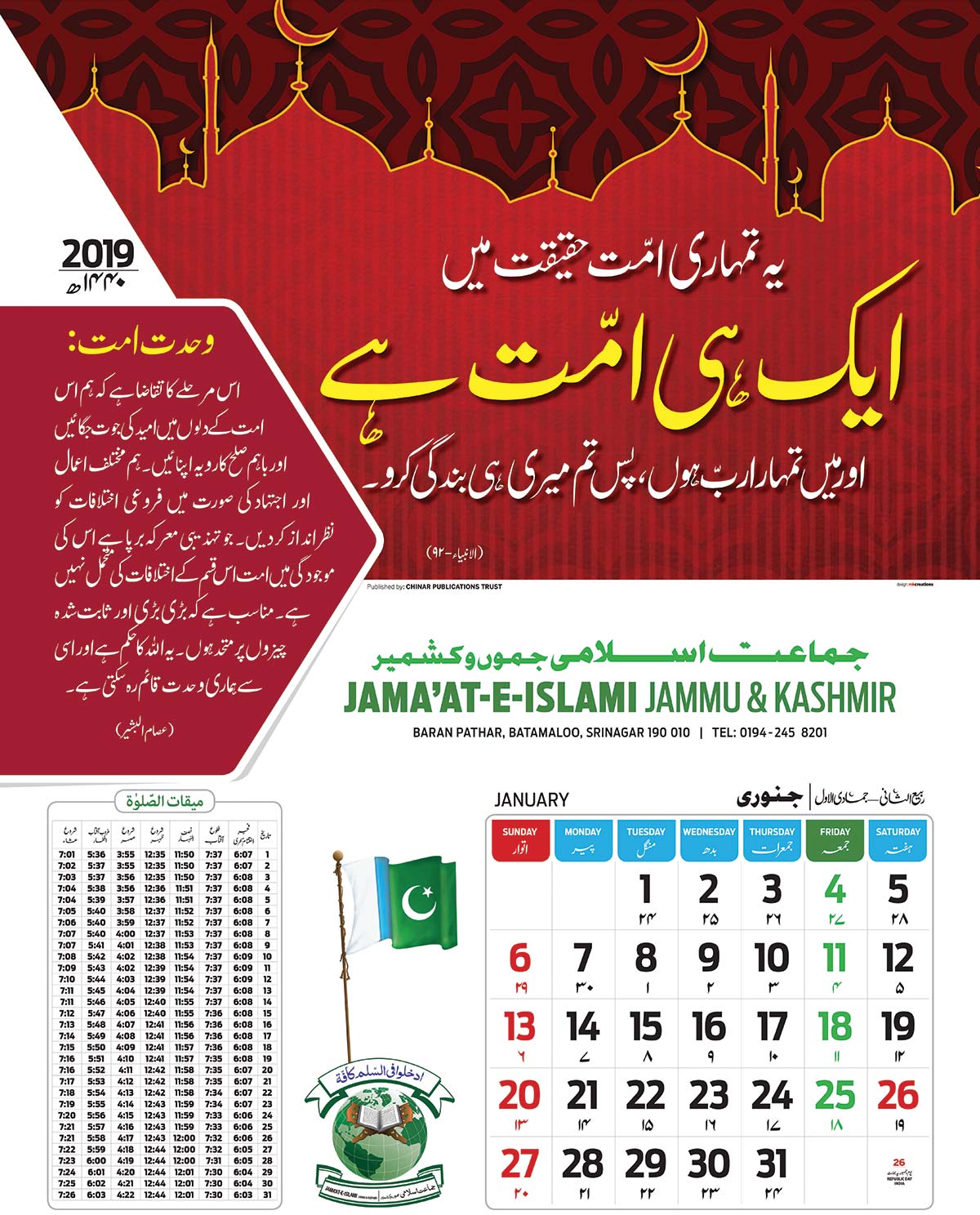For managing 365 days and decorating the kitchen walls, Kashmir alone consumes almost three million wall calendars a year. Detailed the supply and demand, Saima Bhat argues for a printing facility to prevent the flight of capital

For the first time in her married life of 35 years, Hajira Mir missed noting the court hearing of her husband’s civil case on the wall calendar. The calendars in her home are mounted diaries of accounts and important dates – cell phone numbers, peculiar sign numbering to record the milk supply, the encircling of dates when the LPG cylinder was refilled and double circling of dates suggesting when the new edible oil canister was opened.
Mere missing the date of court hearing cost Hajira’s husband a court challan. “I had asked him to tell me the date of hearing but he denied saying he can remember without mentioning it on my messy calendar,” Hajira said. “Nobody can understand the importance of a calendar in my life. I usually forget things like I mostly misplace papers and diaries but calendars have always proven helpful.”
In the first week of every year, Hajira says she becomes restless until she gets the J&K Bank Calendar. “You will always find a J&K Bank calendar in my kitchen,” she said. “It seems that the bank also knows the significance of these wall calendars for the housewives so they give us the privilege of having space between the dates so that we use it to remember.”
Over the years the wall calendars have become a craze in Kashmir, part of a routine life for every household. Even though Kashmiris are major users of smart-phones but the little instrument has not replaced the importance of a wall calendar. This importance has sent almost all companies to ensure a calendar at the end of the year and it has emerged a huge business.
 It is the J&K Bank calendar that tops the chart. Though the quarterly closing of December 31 is more important it is the calendar distribution that dominates the bank business in the first week, every year.
It is the J&K Bank calendar that tops the chart. Though the quarterly closing of December 31 is more important it is the calendar distribution that dominates the bank business in the first week, every year.
Parvez Ahmad, a senior bank employee starts getting calls from most of his relatives: kya sa calendar wotuye ne (we haven’t received a calendar). Once he gets his supply, it takes him three days to distribute among his relatives. “It becomes difficult for a bank employee to distribute calendars between his clients and relatives as we have a limited supply,” Parvez said. “It is the craze possibly because it has better printing, free and accurate on holidays.”
Bank insiders believe the demand is soaring. While they have ordered two million calendars, the actual demand is at 25 lakh pieces.
Managing the tall order is a hectic exercise. It starts in August. A bank insider said selecting a theme is the first task. Usually, four themes are selected by the stationery department and finally one that suits the three regions of State is approved. In the second leg, the hunt for visuals starts. Sometimes, the Bank seeks entries through a public advertisement. One shot is selected from 15 frames. “The frame selection takes place in a panel that the Chairman usually presides,” the insider said. “Usually, six pictures must feature Kashmir, four Jammu and two Ladakh.”
Then the tendering starts and it is the Treasury Department’s prerogative. The size, paper quality and other printing treatments are in focus. Usually, three printers are selected. “These are big publishing houses owning state of the art machines and super-skilled labour,” the insider said. Printers require time for arranging paper. The bank calendar requires around 850 tonnes of glazed art paper.
 Once the system is in place, the bank’s designated designs team starts working on the layout. The final go-ahead comes only after the state government releases the annual holiday list, that usually comes in the first week of December.
Once the system is in place, the bank’s designated designs team starts working on the layout. The final go-ahead comes only after the state government releases the annual holiday list, that usually comes in the first week of December.
“Each printing house usually has four machines and for the next 25 days, they do not take any other job. They work 24 x 7,” the insider said. “By December 29, the supply starts.”
This year, they had hired three printing companies.
The bank calendar is distributed free by the employees and the vast network of branches. But quite a few people know that the calendar has three variants: one for Jammu and Kashmir, another for Mumbai and yet another for northern states including Delhi and Mohali because the holiday’s lists differ.
The calendar is the barometer of a bank’s loyalty. In 2017, there was resentment as the calendar was dedicated to ‘youth icons’. Earlier, a similar situation arose when 12 state artworks were featured.
The ‘icon’ calendar came at a time when Kashmir was nourishing its 2016 wounds. In an immediate reaction, some social networking sites designed the same calendar by replacing the ‘icons’ with slain militant commander Burhan Wani and Insha Mushtaq, who lost her eyes to the pellets.
The second wall calendar in demand is published by the Jamaat e Islamia (JeI) but it is not free. Unlike 2018 when they printed 85,000 copies, they have a 100 thousand order for 2019. It sells Rs 50, apiece.
Insiders in the party said their team starts working from September and the focus is on collecting orders. “We print as per the orders,” Muhammad Ashraf, one of the members of the calendar team, said. “We have pre-orders for our calendar which is not with every calendar in Kashmir.”
“We design it in Kashmir as per our requirements and then only printing is done in Delhi. Every year we prefer to go for Islamic teachings,” says Ashraf. “It is not only members who buy it but we have a demand of the local population as well who love to have Islamic calendars in their houses and these dates are important for Ramadan as well.”
The Tehreek e Hurriyat (TeH) also publishes its own calendars under its official Milat Publications House but the numbers do not exceed 25000. Being sold at Rs 30, these calendars come up with Namaaz timings.
“We have a huge demand and everybody who loves the Kashmir movement is in love with our calendars,” Muhammad Afzal, an employee at Millat Publications, said. “If the situation remains conducive then the demand goes much higher.” Millat is the publisher that owns the rights of Kashmir’s most selling book, Wullar Kinaray, the multi-volume biography of Syed Ali Geelani.
Afzal claimed that in 2012 they reprinted the calendars. In 2011, they had printed diaries as well. “Hamara name he kaafi hai (Our name is enough) for the publicity of our products,” Afzal boated. “Geelani sahib had given a press conference and all of our offices were raided and police seized our entire stock. They even raided booksellers and as a result, many of them refused to sell our calendars for many years to come. Two of our stockists were also booked under cases.”
Off late, Hurriyat (m) also publishes yearly calendars. Usually, they revolve around the history and architecture of Jamia Masjid. The print order is around 10,000 copies.
“Our calendars are exclusive as we print the history of Jamia Masjid, Nimaaz timings, Ramadan and other important dates,” Syedurrehman Shamas, an aide of Mirwaiz Umer Farooq, said. “Our clientele are Masjids and main centres and religious organisations.” Earlier, the calendar was distributed free but this year it sells at Rs 100 apiece.
Student organisation Islami Jamiat ul Tulba also prints its own calendars, around 25000 a year of which around 1000 copies are complimentary.
Their calendar is sold for Rs 30 per copy outside Masjids. But the important part of this calendar, Advocate Abid Bhat, a member of this organisation, said: “Our aim is mostly education and you will find out only informative content in our calendars like the local history which you hardly find in textbooks and other socio-politico information.”
The distribution of this calendar is being done across the state but its members share the instances when a member of this organisation saw a calendar in the house of Muslim family in Punjab.
“Kashmiris are politically very mature and when it comes to religion you will find them divided,” insists Abid. “You will never find a calendar of Hanfis’ in Ahalhadees family but there is no such tag attached to ours. You will find our calendars in homes across the sectoral divide.”
For the business, the calendar is part of the brand promotion and a visible indicator of influence in the market. Khyber Group of Industries, Kanwal Foods, HK Cements, Arco, Saifco Cements – all print tens of thousands of wall calendars and diaries and distribute free through their vast network of dealers and sub-stockists.
The Kanwal Foods prints almost 25000 calendars. “Ours is most loved because we publish Islamic dates as well and that part is mostly liked by people, Iftikhar Ahmad, a senior executive of the company said. “We are in demand but we can’t tackle it as it costs around Rs 100 apiece.”
Khyber Group of Industries is a key player in the wall calendar and diaries. In fact, this group triggered the trend some 15 years back. “We have been investing hugely in brand promotion over the years,” Umer K Tramboo, Managing Director of the Group said. “Wall calendar is part of the same process that our huge clientele is so keen to have in their homes. We print around one lakh calendars.”
 Over the years the essence of calendars was realised by special interest groups and individuals. In 2008, a retired chief engineer and owner of a hotel Madhuban in Gagribal near Nehru Park, Showkat Rasheid Wani decided to print calendars showcasing Kashmir’s pictures from the past. His calendar Nostalgic Kashmir is a collection of rare photographs and paintings of Kashmir from the 1850s to 1950s. He continued to publish it till 2014 but after September deluge he had to stop for three years to revive the whole process.
Over the years the essence of calendars was realised by special interest groups and individuals. In 2008, a retired chief engineer and owner of a hotel Madhuban in Gagribal near Nehru Park, Showkat Rasheid Wani decided to print calendars showcasing Kashmir’s pictures from the past. His calendar Nostalgic Kashmir is a collection of rare photographs and paintings of Kashmir from the 1850s to 1950s. He continued to publish it till 2014 but after September deluge he had to stop for three years to revive the whole process.
In 2019, Showkat’s son, Wasim Showkat Wani, who is mostly overseeing the printing of these calendars, said they published the ninth in the series. “We only print 500 to 1000 copies every year because our calendar costs Rs 250 apiece and only specific people, who know the value of these pictures buy it.” He also gives 100 copies as complimentary.
But this year a new ‘form of expression’ was started by two young Kashmiri girls, Sama Beg and Onaiza Drabu, 28, who want this year to be remembered for the legendary women of Kashmir, who are lesser known but have worked selflessly for the society.
For this, they chose nine young artists who worked on canvas to pay tribute to 12 Kashmiri women for their cultural contributions and make difference in the society, including educationist Muriel Johnson (miss Mallinson), Hanifa Chapu and Giyani Mohan Kaur, legendary singer Raj Begum, queen Deeda and Kota Rani, famous poets Lal Ded, Arnimal, Rupa Bhawani and Habba Khatoon, lady known for having a museum Aatiqa Bano and the legendary doctor Dr Girja Dhar.
Sama says it is a tribute by “women to other women.” The art varies from watercolour to drawing sketches, digital drawing, and canvas making.
The product was jointly conceptualised by Sonth Kashmir, a quirky Kashmiri stationery brand, and Koshur Lifestyle, called Koshur Wear, a contemporary brand that celebrates Kashmiri culture. They have put a cost to it and it is Rs 575 and 475 per wall calendar and a table calendar.
 The calendar has emerged as a communication system for various special interest groups. Association of Parents of Disappeared People (APDP), for instance, is publishing its calendars as a ‘form of memory’ since 2016. Every year twelve pictures get printed on the calendar detailing how the person disappeared.
The calendar has emerged as a communication system for various special interest groups. Association of Parents of Disappeared People (APDP), for instance, is publishing its calendars as a ‘form of memory’ since 2016. Every year twelve pictures get printed on the calendar detailing how the person disappeared.
This time APDP printed 900 copies. “These calendars are distributed free among these victim families but other than that many researchers, journalist, students, professors, human right workers and even common masses come and buy the calendars,” says Sabia, one of the senior members of APDP, who sees the publicity part of the organisation.
For common masses, it could be a routine calendar but for these families, it is quite painful to see the pictures of their disappeared family members for the whole month. But once the year changes, these calendars are mainly preserved by the people for the future reference.
“Now we get desperate calls from our members like why their missing members were not featured in the calendar,” Sabia said. “But it takes time to identify one particular individual and feature it.”
It may not be common knowledge that Jammu and Kashmir government also prints an official calendar which sells at Rs 30. But its circulation and use is insignificant. Off late, however, almost all the government departments are publishing their own calendars’ in bulk. There is no idea about how many calendars are being printed and how they are being distributed.
There are two departments which publish luxury calendars at huge costs but the supply is too little: the Tourism department and JKTDC. Interestingly, the Tourism department is printing separate calendars for Kashmir and Jammu. Police and the Prisons Department are also printing their own calendars to highlight their own contributions.
In 2018, it triggered an interesting crisis. One department added a day to a month and another reduced a day from another month. “At one point of time, there was a proposal that all the departments should pool the funds in a single account so that the government can print one major calendar as a communication with the people and every family gets one copy,” one top officer said. “But department felt that it will undermine their individual decision-making.”
There is no clear idea about the costs at which Jammu and Kashmir is retaining the newfound tradition for the wall calendar. “It must be a few hundred crores,” one insider in the printing sector said. “But the tragedy is that all this results in capital flight. We lack adequate facility within Kashmir and that is a tragedy.”















